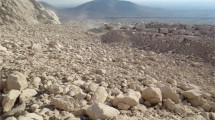Abstract
The paper proposes a standardized image-processing procedure with the use of sieve analysis results for calibration which is utilized to measure the size distribution of fragmentation at Sungun mine. Through this procedure, a number of 19 bench blasting in various levels have been initially selected as the target of the study for each, multiple photos were taken immediately after blast from suitable perspectives and locations of the muckpiles surfaces. The number of image sampling was chosen adequately high to achieve further reliability of the whole photography procedure. Then fragments of each muckpile were separately mixed by a loader, where another image sampling from these new muckpiles, bucket of loaders, and haulage trucks was performed. For the purpose of sieve analysis, seven sieves with the mesh sizes between 1.27 cm (0.5 in) and 25.4 cm (10 in) were designed, manufactured, and then installed at Sungun semi-industrial laboratory. Additionally, three mass samples of the mixed fragments were randomly chosen among the 19 muckpiles for sieving. During image analysis stage, “sieve shift” and “mass power” factors, required to obtain standardized size distribution, were precisely assigned when the results obtained by the image analysis software was in accordance with the sieving results. In order to validate the reliability of the image processing, a comparative analysis of the achieved results was made with the results of the original Kuz–Ram model [Cunningham (1983) The Kuz–Ram model for prediction of fragmentation from blasting. In: Proceedings of the first international symposium on rock fragmentation by blasting, Lulea, Sweden, pp 439–454]. Finally, the image-processing procedure was found to be more efficient, with results close-matched to the real results of the sieve analysis.








Similar content being viewed by others
References
Bahrami A, Monjezi M, Goshtasbi K, Ghazvinian A (2010) Prediction of rock fragmentation due to blasting using artificial neural network. Eng Comput. doi:10.1007/s00366-010-0187-5
Chakraborty AK, Raina AK, Ramulu M, Choudhury PB, Haldar A, Sahu P, Bandopadhyay C (2004) Parametric study to develop guidelines for blast fragmentation improvement in jointed and massive formations. Eng Geol 73:105–116
Chung SH, Katsabanis PD (2000) Fragmentation prediction using improved engineering formulae. Int J Blasting Fragment (Fragblast) 4:198–207
Cunningham CVB (1983) The Kuz–Ram model for prediction of fragmentation from blasting. In: Proceedings of the first international symposium on rock fragmentation by blasting, Lulea, Sweden, pp 439–54
Cunningham CVB (1987) Fragmentation estimations and Kuz–Ram model—four years on. In: Proceedings of 2nd International Symposium on Rock Fragmentation by Blasting. Keystone, Colorado, pp 475–487
Cunningham CVB (2005) The Kuz–Ram fragmentation model—20 years on. In: Proceedings 3rd EFEE world conference on explosives and blasting, England, pp 201–210
Gheibie S, Aghababaei H, Hoseinie SH, Pourrahimian Y (2009) Modified Kuz–Ram fragmentation model and its use at the Sungun copper mine. Int J Rock Mech Mining Sci 46:967–973
Golder Associates (1997) Gold size 2.0 an interactive system for blast fragmentation analysis and optimization. Product catalogue
Grundstrom C, Kanchibotla S, Jankovic A, Thornton DM (2001) Blast fragmentation for maximizing the SAG mill throughput at Porgera goldmine. In: Proceedings of the 27th annual conference on explosives and blasting technique, Orlando, FL, pp 383–399
Hall J, Brunton I (2002) Critical comparison of Julius Kruttschnitt Mineral Research Centre (JKMRC). Int J Blasting Fragment (Fragblast) 6(2):207–220
Kanchibotla SS, Valery W, Morrell S (1999) Modeling fines in blast fragmentation and its impact on crushing and grinding. In: Proceedings of the Explo-99 conference, Kalgoorlie, Australia, pp 137–144
Kulatilake PHSW, Qiong Wu, Hudaverdi T, Kuzu C (2010) Mean particle size prediction in rock blast fragmentation using neural networks. Eng Geol 114:298–311
Latham JP, Meulen JV, Dupray S (2006) Prediction of fragmentation and yield curves with reference to armourstone production. Eng Geol 87:60–74
Lilly PA (1986) An empirical method of assessing rock mass blastability. In: Proceedings of the large open pit planning conference, Parkville, Victoria, Australian IMM, pp 89–92
Monjezi M, Rezaei M, Yazdian Varjani A (2009) Prediction of rock fragmentation due to blasting in Gol-E-Gohar iron mine using fuzzy logic. Int J Rock Mech Mining Sci 46:1273–1280
Monjezi M, Amiri H, Farrokhi A, Goshtasbi K (2010) Prediction of rock fragmentation due to blasting in Sarcheshmeh copper mine using artificial neural networks. Geotech Geol Eng 28:423–430
Morin MA, Ficarazzo F (2006) Monte Carlo simulation as a tool to predict blasting fragmentation based on the Kuz–Ram model. Comput Geosci 32:352–359
Ouchterlony F (2005) The Swebrec function: linking fragmentation by blasting and crushing. Mining Technol Trans Inst Min Metall A 114:29–44
Ozkahraman HT (2006) Fragmentation assessment and design of blast pattern at Goltas limestone quarry, Turkey. Int J Rock Mech Mining Sci 43:628–633
Rosin P, Rammler E (1933) The laws governing the fineness of powdered coal. J Inst Fuel 7:29–36
Sanchidrian JA, Segarra P, Lopez LM (2006) A practical procedure for the measurement of fragmentation by blasting by image analysis. Rock Mech Rock Eng 39(4):359–382
Spathis AT (2004) A correction relating to the analysis of the original Kuz–Ram model. Int J Blasting Fragment Fragblast 8(4):201–205
Acknowledgment
The authors are gratefully thankful to all managers, masters, and engineers of the Sungun copper mine for their kindly help and cooperation during this long-term study. Special thanks go to the aid of all supervisors for generating the best condition during the photo sampling and sieve analysis. We would also like to thank the other people who gave us the valuable notes and comments.
Author information
Authors and Affiliations
Corresponding author
Rights and permissions
About this article
Cite this article
Badroddin, M., Bakhtavar, E., Khoshrou, H. et al. Efficiency of standardized image processing in the fragmentation prediction in the case of Sungun open-pit mine. Arab J Geosci 6, 3319–3329 (2013). https://doi.org/10.1007/s12517-012-0552-3
Received:
Accepted:
Published:
Issue Date:
DOI: https://doi.org/10.1007/s12517-012-0552-3




